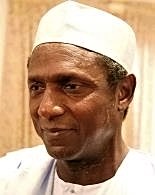Loading AI tools
Cap worn primarily by Muslim men and men of West African heritage From Wikipedia, the free encyclopedia
A kufi or kufi cap is a brimless, short, and rounded cap worn by men in many populations in North Africa, East Africa, West Africa, South Asia, and the Middle East.[1] It is also worn by men throughout the African diaspora. The cap has strong associations with many Islamic cultures and pan-African pride.[2] In the United States and the United Kingdom, it is also called a "taqiyah".[3][4][5][6]

The kufi cap is not specific to any one country, although it has been perhaps most associated with Nigeria.[7] In Togo, the kufi is made from colourful fabrics, and are often worn during important events such as weddings, festivals, and other ceremonies.[8] In Mama Tchamba performances, the kufi is worn as an adornment during dances.[9] Within Islamic communities in West Africa the kufi is worn during prayer.[10]
The hat has strong associations with many Islamic cultures, as well as Pan-African pride.[11] In West Africa, a kufi cap is the traditional hat for men, and is part of the national costume of most of the countries in the region. It is worn by Muslims, and African Christians. Many grandfathers and other older men wear a kufi every day to symbolize their status as wise elders, religious people, or family patriarchs.[12]
Within the United States, it has become identified primarily with persons of West African heritage, who wear it to show pride in their culture, history, and religion (whether Christianity, Islam, or Traditional African religions). It is often made of kente cloth, mudcloth, or knitted or crocheted in a variety of yarns.[citation needed]
Crown style kufis are the traditional hat worn with formal West African attire.[13] A formal dashiki suit will always include a crown style kufi, while the knitted style is most appropriate for non-formal occasions. Other caps worn with the dashiki, Senegalese kaftan, and grand boubou, include:[citation needed]
However, the crown style kufi is most common.[citation needed]
In the United States today, many African-Americans wear the kufi during weddings, funerals, graduations and Kwanzaa celebrations. Furthermore, people of mainly West African heritage of all faiths wear the kufi, although it is associated more with members of the Islamic faith.[citation needed]
A West African king or tribal chief may have royal or noble arms embroidered on the kufi.[citation needed]
For members of the Christian faith, the kufi is unisex, and is also worn by women. Crochet and knitted styles are preferred by young girls and infants.[citation needed]
Traditionally, when worn by men, the kufi is a sign of peace, mourning, renewal or protection of the mind.[citation needed]
In the Yoruba language, Ade means crown, and fila means cap. The city of Kufi is located in Yorubaland near Ibadan. Other West African names include fula, fila, and malo hat.[14] This cap is called a kofia in the Swahili language of East Africa[15] (see the kanzu article for further information). In the United States, the West African name, kufi, is most commonly used.[citation needed]

Jazz rock/jazz fusion Weather Report frontman and keyboardist Joe Zawinul wore kufi caps for a long time, both on stage with the band and outside of it, in his private/personal life. He is known for having changed various kufi models throughout the passing of time as well, as shown in the live performances of Weather Report from the 1970s and 1980s. Progressive rock Dutch legend Thijs van Leer also wore kufi caps during his early career with his band, Focus, in the 1970s. He can be seen wearing one in the music video for "House of the King" (also the theme song for the British TV show Saxondale). In addition, Rush drummer Neil Peart took to wearing a kufi during performances after touring Cameroon by bicycle in 1988.[citation needed]
In the beginning of the 2018 American action film The Equalizer 2, the character Robert McCall, played by Denzel Washington, is seen disguised as a Muslim and wearing a kufi.[16]
The caps were featured as dancers in the 2018 music video "All the Stars" by the artist Kendrick Lamar.[17][18]
Seamless Wikipedia browsing. On steroids.
Every time you click a link to Wikipedia, Wiktionary or Wikiquote in your browser's search results, it will show the modern Wikiwand interface.
Wikiwand extension is a five stars, simple, with minimum permission required to keep your browsing private, safe and transparent.